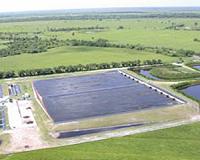| . |  |
. |
Cairo (AFP) May 13, 2010 A senior EU envoy urged seven east African countries on Thursday to settle differences with Egypt and Sudan over sharing the waters of the Nile river and refrain from signing a new deal on their own. Marc Franco, who heads the European Union delegation in Egypt, issued the appeal as Burundi, Democratic Republic of Congo, Ethiopia, Kenya, Rwanda, Tanzania and Uganda were expected to launch the signing on Friday of a new water-sharing deal. The agreement would replace a 1959 accord betweeb Egypt and Sudan that gives them control of more than 90 percent of the water flow. It would "not be a very good idea for seven countries to sign a document at this stage," Franco told a news conference in Cairo. A separate deal would "make the political problems that exist worse," Franco said, urging all countries concerned "to bridge the gaps" and "see what can be done to find a compromise." The seven upstream countries have been negotiating for years with Egypt and Sudan to clinch a more equitable agreement but talks have failed to produce any fruit. They have agreed on terms for a new pact and could ink the deal when it opens for signature on Friday in Entebbe. "What we are doing is launching the signing. Any country that feels they cannot sign now but may be ready to sign later will have one year," Jennifer Namuyangu Byakatonda, Uganda's state minister for water told AFP in Kampala. Byakatonda insisted that the upstream countries will not capitulate to demands for further negotiations. "Negotiations are closed," she said. "The terms will not change." The upstream countries want to implement irrigation and hydropower projects in consultation with Egypt and Sudan but Cairo could exercise the veto power it was given by a 1929 colonial-era treaty with Britain. Egypt and Sudan are afraid their water supply will be severely reduced if the seven other Nile users divert the river with domestic irrigation and hydropower projects. Egyptian Foreign Minister Ahmed Abul Gheit warned in statements published on Saturday that Cairo's water rights were a "red line" and threatened legal action if a unilateral deal is reached.
earlier related report Researchers at Oak Ridge National Laboratory say current laboratory-based technologies for analysis of water contaminants are time-consuming, labor-intensive and expensive compared with their technology. They said their proprietary system -- called membrane-extraction ion mobility spectrometry -- is a single compact device able to detect aqueous tetrachloroethylene and tricholoroethylene concentrations as low as 75 micrograms per liter with a monitoring duty cycle of three minutes. Jun Xu, who led the study, said the system can reduce the cost of long-term monitoring by up to 80 percent. "Based on this technology, a field-deployable sensor can be made and you would no longer need to have someone take a groundwater sample from a well and ship it to a laboratory for testing," Xu said. "The ORNL sensor does all three of these tasks in one step and very quickly, saving money." He said the sensor can also be configured to monitor well, tap or river water or other water suspected of having an undesirable or possibly illegal level of contamination. Also, additional membranes with different properties can be installed to enable collection of a wider variety of contaminants. The research that included Yongzhai Du, Wei Zhang, William Whitten and David Watson of ORNL and Haiyang Li of the Dalian Institute of Chemical Physics in China appears in the journal Analytical Chemistry.
Share This Article With Planet Earth
Related Links Water News - Science, Technology and Politics
 Algae Advances As A Green Alternative For Improving Water Quality
Algae Advances As A Green Alternative For Improving Water QualityWashington DC (SPX) May 13, 2010 Algae - already being eyed for biofuel production - could be put to use right away to remove nitrogen and phosphorus in livestock manure runoff, according to an Agricultural Research Service (ARS) scientist. That could give resource managers a new eco-friendly option for reducing the level of agricultural pollutants that contaminate water quality in the Chesapeake Bay. Microbiologist Walte ... read more |
|
| The content herein, unless otherwise known to be public domain, are Copyright 1995-2010 - SpaceDaily. AFP and UPI Wire Stories are copyright Agence France-Presse and United Press International. ESA Portal Reports are copyright European Space Agency. All NASA sourced material is public domain. Additional copyrights may apply in whole or part to other bona fide parties. Advertising does not imply endorsement,agreement or approval of any opinions, statements or information provided by SpaceDaily on any Web page published or hosted by SpaceDaily. Privacy Statement |